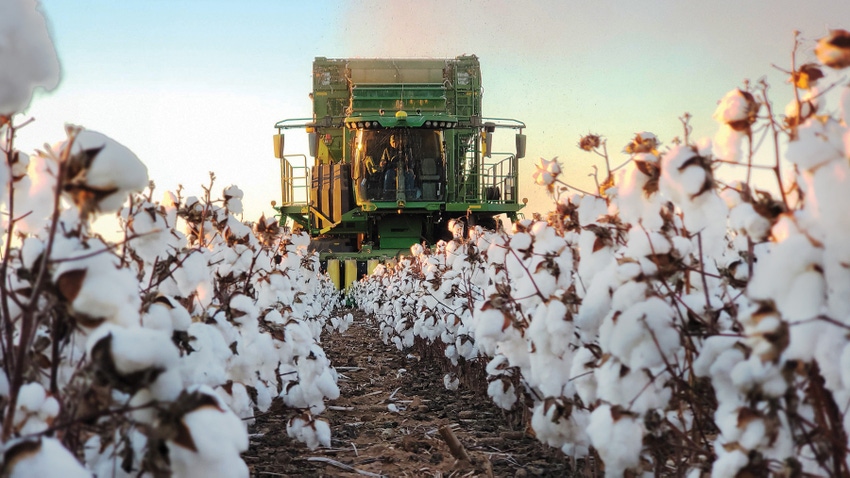
Axant Flex, a four-trait herbicide tolerant cotton will add another tool to augment residual herbicide use.
“Residual herbicides are extremely important in cotton production,” said Jenny Dudak, Oklahoma State University, Ardmore.
Dudak, speaking at the 35th annual Texas Plant Protection Association Conference in Bryan back in December, explained that BASF is integrating a tolerance trait to Alite 27 (an HPPD inhibitor) in cotton. “BASF has integrated Alite 27 tolerance into FiberMax and Stoneville varieties,” she said. Dudak detailed multi-year studies that evaluated Axant Flex on weed efficacy, cotton response and lint yield.
A multi-year (2021-2023) research project included sites at various locations across Oklahoma and Texas, including Bixby, Altus, and Fort Cobb, Okla., and College Station, Texas.

Jenny Dudak, Oklahoma State University. She will take over as the state's Extension cotton specialist in May upon graduation with her Ph.D. (Photo by Shelley E. Huguley)
The trials included “HPPD-tolerant cotton planted and managed based on local growing practices,” Dudak said.
Herbicide treatments included: PRE: Alite 27 (3 fl oz/A) alone and either Direx/Cotoran (24-32 fl oz/A) or Sinister/Brake (12-24 fl oz/A) alone or in combination with Alite 27. In 2022, Prowl H2O (32 fl oz/A) alone and in combination with Alite 27 (3 fl oz/A) was added to the treatment list. All PRE treatments were followed by a POST application of Engenia (12.8 fl oz/A ) + Outlook (12.8 fl oz/A) + Roundup PM II (32 fl oz/A) + Aegos (8 fl oz/A).
Results are promising. “In 2021, cotton injury was less than 10% at all locations,” Dudak said. “In 2022, all locations were less than 10%, except for Ty Ty, Georgia." Although data was not presented for the Georgia location, Dudak found it pertinent to share injury results, “This injury was likely exacerbated by extremely hot temperatures, high humidity, and excessive irrigation. “In 2023, injury across all locations was less than 10%, except for College Station. That included some initial crop injury blanketed across the trial and was likely due to weather conditions at planting and immediately after planting.”
Control results
Dudak said early season results showed Palmer amaranth control at least 96% with Alite 27 in combination with Prowl H2O in 2022 and 2023 at all locations.
“Alite 27 in combination with Direx was at least 98% at all locations all three years.” Late-season ratings were also good. “Four weeks after the post-treatment went out, Alite 27, in combination with Prowl H2O, controlled Palmer amaranth by at least 95% in 2022 and 2023 across all four locations. Alite 27 in combination with Direx was at least 93% effective across all site years.”
Dudak detailed early season annual grass control ratings. “Two weeks after PREs went out in 2021, grass control was greater than 93% at all locations. In 2022, Alite 27 applied alone resulted in at least 91% control while the three tank mix combinations controlled annual grass at least 96% early season at all locations.” She said 2023 early season ratings showed all treatments greater than 91% except for Prowl H2O, at 81% at College Station.
In 2021 late season ratings, taken four weeks after the POST treatment application, all treatments resulted in greater than 90% control of annual grass, except for Alite 27 alone at Fort Cobb, Okla., and Sinister alone at Bixby, Okla. In 2022, the three tank mix combinations controlled at least 90% of annual grass across the state of Oklahoma. In 2023, the three tank mix combinations and Alite 27 alone controlled annual grass at least 93% across all locations. “Over the three year trial, we saw excellent early season control of Palmer amaranth with Alite 27 applied in combination with Direx or Caparol all three years, and with Prowl H2O in the two years it went out,” Dudak said.
“Similar results were observed with late season Palmar amaranth control with Alite 27 in combination with Direx or Caparol and Prowl H2O followed by a POST tank mix combination.
“We also recorded consistently acceptable season-long grass control with Alite 27 tank mix combinations across all locations all three years.
Alite 27 characteristics
Dudak says Alite 27 activation occurs with approximately a 1/2 inch of irrigation. “Alite 27 works by disrupting carotenoid production. Carotenoids act as a sunblock for chlorophyll pigments within the plant. When production is halted, the plant is essentially vulnerable to sunburn, which is the typical bleaching symptomology resulting from an application of HPPD herbicides.”
Target weeds include Palmer amaranth, marestail, kochia, Texas panicum, and large crab grass, among others.
“BASF plans to market Alite 27 as a flexible product based on application timing,” Dudak said. “Producers can apply this product from burndown all the way to early post or up to four-leaf cotton. In Oklahoma, we expect to see this product applied mainly behind the planter as a PRE to conserve some of the Group 15 herbicides for POST residual applications.”
Dudak said, according to the Alite 27 soybean label, most of the crops Oklahoma producers will rotate to will have less than six months with no irrigation or precipitation requirements.
“It is important to point out, however, that if you have a replant situation, you will have to replant an Axant Flex variety.”
Editor's note: “Alite 27 herbicide (EPA Reg. No. 7969-433) is not registered for use on isoxaflutole-tolerant cotton nor available for sale for such use.”
About the Author(s)
You May Also Like






